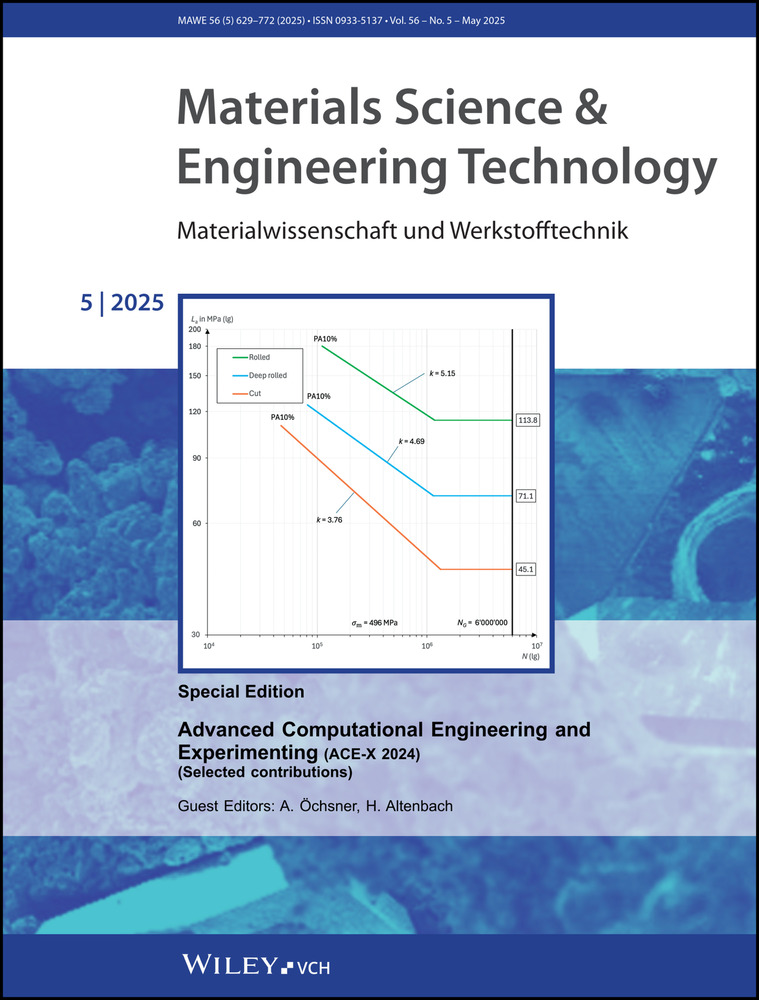Influence of cellulose fiber reinforcement in mechanical and morphological properties of polyurethane-silica aerogel composites for thermal insulation applications
Einfluss der Zellulosefaserverstärkung auf die mechanischen und morphologischen Eigenschaften von Polyurethan-Silica Aerogel-Verbundwerkstoffen für Wärmedämmanwendungen
Abstract
enPolyurethane-silica aerogel (PUSA) composite has shown promising performance in thermal insulation application, owing to its microstructure that offers thermal resistance within its cellular matrix. The inclusion of silica aerogel into polyurethane enhances both the mechanical and thermal properties of the composite. Previous research reported 1 wt.–% silica aerogel loading as optimal in material compressive strength and higher concentrations was found to negatively impact the cell structure and ultimately hinder thermal performance. In the quest for enhanced properties cellulose fibre (CF) was introduced into polyurethane-silica aerogel. Composites with variable loading of cellulose fibre (0.5 wt.–%, 0.75 wt.–% and 1.0 wt.–%) as PUCF1S, PUCF2S and PUCF3S were fabricated. It was found that composite PUCF2S has the highest compressive strength of 0.92 MPa, demonstrating 64 % increase compared to pristine composite (polyurethane-silica aerogel). The matrix microstructure as revealed by field emission scanning electron microscopy was discovered to have uniform cell size facilitated by uniform particle dispersion within the matrix. The cellulose fibre participated in the cell nucleation leaving behind an enhanced cell with reduced cell size that supports compressive loads and thermal insulation performance.
Translation abstract
deDer Verbundwerkstoff Polyurethan-Silica Aerogel (PUSA) hat sich aufgrund seiner Mikrostruktur, die innerhalb seiner Zellmatrix Wärmewiderstand bietet, als vielversprechend in der Wärmedämmung bewährt. Die Einbeziehung von Silica Aerogel in Polyurethan verbessert sowohl die mechanischen als auch die thermischen Eigenschaften des Verbundwerkstoffs. Frühere Untersuchungen ergaben, dass ein Silica Aerogel-Anteil von 1 Gew.–% optimal für die Druckfestigkeit des Materials ist, und höhere Konzentrationen haben sich negativ auf die Zellstruktur ausgewirkt und letztlich die Wärmeleistung beeinträchtigt. Auf der Suche nach verbesserten Eigenschaften wurde Zellulosefaser (CF) in Polyurethan-Silica Aerogel eingeführt. Es wurden Verbundwerkstoffe mit variablem Zellulosefaser-Anteil (0,5 Gew.–%, 0,75 Gew.–% und 1,0 Gew.–%) als PUCF1S, PUCF2S und PUCF3S hergestellt. Es wurde festgestellt, dass der Verbundwerkstoff PUCF2S die höchste Druckfestigkeit von 0,92 MPa aufweist, was einer 64 prozentigen Steigerung im Vergleich zum ursprünglichen Verbundwerkstoff (Polyurethan-Silica Aerogel) entspricht. Die durch Feldemissions-Rasterelektronenmikroskopie enthüllte Matrixmikrostruktur wies eine gleichmäßige Zellgröße auf, die durch eine gleichmäßige Partikeldispersion innerhalb der Matrix ermöglicht wurde. Die Zellulosefaser war an der Zellbildung beteiligt und hinterließ eine verbesserte Zelle mit reduzierter Zellgröße, die Druckbelastungen standhält und eine gute Wärmedämmung bietet.
Conflict of Interests
The authors declare no financial or commercial conflict of interest.
Open Research
Data Availability Statement
The data that support the findings of this study are available from the corresponding author upon reasonable request.




